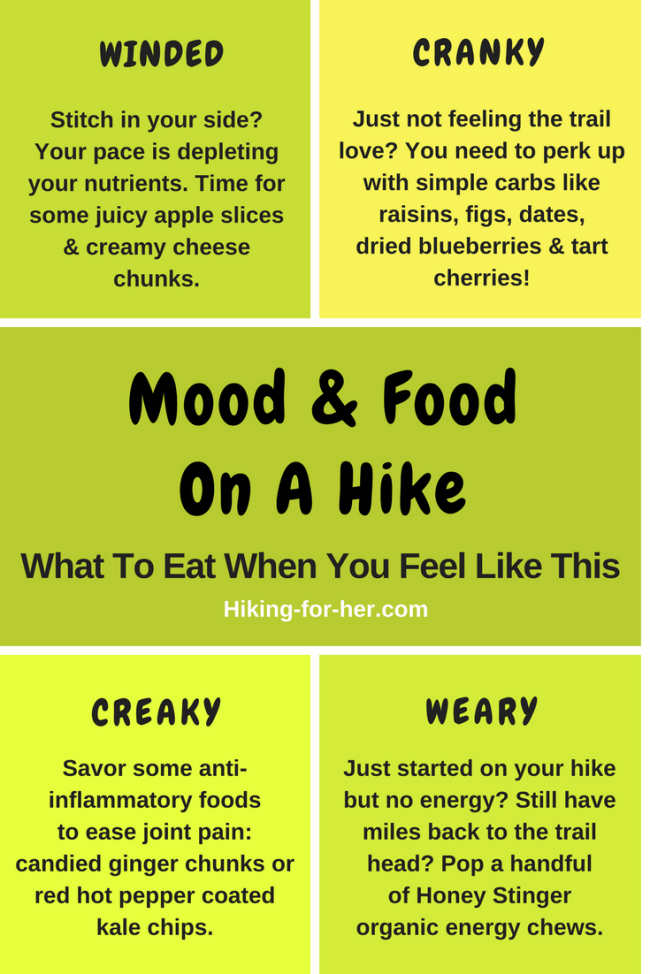
Image source: https://www.hiking-for-her.com/images/MoodFoodWindedCrankyCreakyWeary.png
Here's a meal-by-meal guide to eating for energy and managing your mood with food.
Breakfast
Eating a good breakfast boosts your concentration and revs your energy, particularly in the morning when you may need it most. Without breakfast, you're more likely to make that second pot of coffee by mid-morning.
Instead, keep your blood sugar on an even keel with complex carbohydrates. Avoid refined carbohydrates, such as white bread and white sugar. These have a high glycemic index, which can cause spikes and dips in your blood sugar levels.
The right complex carbohydrates provide your brain and muscles with the steady flow of the energy they need. Grains are great sources of B vitamins, which aid in the metabolic production of energy. The best carb choices for breakfast are natural whole-grain breads and cereals.
For the best breakfast, add a low-fat protein, such as yogurt, cottage cheese, or skim milk, and watch your fat intake as well as your meat consumption (meat takes more energy to digest).
Mid-morning snack
Turns out, snacking may not be such a bad idea. Eating every few hours helps your body use nutrients more efficiently. It stimulates your metabolism, keeps your blood sugar levels steady, reduces stress on your digestive system, and decreases hunger, which means you'll be less likely to overeat when mealtime finally rolls around.
If you're craving carbs, which many of us do at this time of day, choose whole-grain bread, cereal, or fruit. Fruits and vegetables deliver a low-fat, high-fiber alternative to the vending machine choices. Raw carrots and sugar snap peas, for example, provide a crisp, satisfying crunch and won't zap your energy. Challenge yourself to eat at least five servings of fruits and vegetables each day.
For maximum energy throughout the day, avoid foods that are laden with simple sugars, such as cookies, pastries, candy bars, and sodas, which can bring on erratic blood sugar levels.
Instead, try some lean protein (low-fat yogurt, cottage cheese or lean meat) to help tide you over until lunch.
Lunch
At midday, go light. Because a hefty helping of carbohydrates can increase the amount of seratonin in the brain and cause that sleepy feeling, focus on low-fat protein. Protein can actually raise energy levels by increasing brain chemicals called catecholamines. Eat a lunch of low-fat cheese, fish, lean meat, poultry, or tofu.
Mid-afternoon snack
Choose something that will keep you satisfied until dinner. A little bit of fat is fine. It gives those carbohydrates and proteins some staying power. My favorite? All-natural peanut butter and a few crackers.
Before your work-out
Carbohydrates are fastest to digest and pack quick energy. Add protein for staying power, but stay away from fats. They can make you cramp.
Dinner
The agenda for the evening can dictate what you'll eat for dinner. Need to stay on overdrive for back-to-school night? Choose low-fat proteins. If you're in relax mode, indulge a little.
Whatever's on the menu, remember the Pie Test. Envision your plate as a pie. Seventy-five percent of the pie should be filled with fruits, vegetables, and grains and 25 percent with other foods, such as diary products and meat.
Before bed
Before turning in, a carbohydrate-rich snack can supply seratonin to help you fall asleep. But go easy. Too much food can reduce the quality of your sleep.
Eating for energy is one of the most effective, powerful, and fast-acting mood-boosters. Try it today and see!
